Nathaniel D. Bastian
ORCA: Agentic Reasoning For Hallucination and Adversarial Robustness in Vision-Language Models
Sep 18, 2025Abstract:Large Vision-Language Models (LVLMs) exhibit strong multimodal capabilities but remain vulnerable to hallucinations from intrinsic errors and adversarial attacks from external exploitations, limiting their reliability in real-world applications. We present ORCA, an agentic reasoning framework that improves the factual accuracy and adversarial robustness of pretrained LVLMs through test-time structured inference reasoning with a suite of small vision models (less than 3B parameters). ORCA operates via an Observe--Reason--Critique--Act loop, querying multiple visual tools with evidential questions, validating cross-model inconsistencies, and refining predictions iteratively without access to model internals or retraining. ORCA also stores intermediate reasoning traces, which supports auditable decision-making. Though designed primarily to mitigate object-level hallucinations, ORCA also exhibits emergent adversarial robustness without requiring adversarial training or defense mechanisms. We evaluate ORCA across three settings: (1) clean images on hallucination benchmarks, (2) adversarially perturbed images without defense, and (3) adversarially perturbed images with defense applied. On the POPE hallucination benchmark, ORCA improves standalone LVLM performance by +3.64\% to +40.67\% across different subsets. Under adversarial perturbations on POPE, ORCA achieves an average accuracy gain of +20.11\% across LVLMs. When combined with defense techniques on adversarially perturbed AMBER images, ORCA further improves standalone LVLM performance, with gains ranging from +1.20\% to +48.00\% across evaluation metrics. These results demonstrate that ORCA offers a promising path toward building more reliable and robust multimodal systems.
TOGA: Temporally Grounded Open-Ended Video QA with Weak Supervision
Jun 11, 2025Abstract:We address the problem of video question answering (video QA) with temporal grounding in a weakly supervised setup, without any temporal annotations. Given a video and a question, we generate an open-ended answer grounded with the start and end time. For this task, we propose TOGA: a vision-language model for Temporally Grounded Open-Ended Video QA with Weak Supervision. We instruct-tune TOGA to jointly generate the answer and the temporal grounding. We operate in a weakly supervised setup where the temporal grounding annotations are not available. We generate pseudo labels for temporal grounding and ensure the validity of these labels by imposing a consistency constraint between the question of a grounding response and the response generated by a question referring to the same temporal segment. We notice that jointly generating the answers with the grounding improves performance on question answering as well as grounding. We evaluate TOGA on grounded QA and open-ended QA tasks. For grounded QA, we consider the NExT-GQA benchmark which is designed to evaluate weakly supervised grounded question answering. For open-ended QA, we consider the MSVD-QA and ActivityNet-QA benchmarks. We achieve state-of-the-art performance for both tasks on these benchmarks.
Neurosymbolic Artificial Intelligence for Robust Network Intrusion Detection: From Scratch to Transfer Learning
Jun 04, 2025Abstract:Network Intrusion Detection Systems (NIDS) play a vital role in protecting digital infrastructures against increasingly sophisticated cyber threats. In this paper, we extend ODXU, a Neurosymbolic AI (NSAI) framework that integrates deep embedded clustering for feature extraction, symbolic reasoning using XGBoost, and comprehensive uncertainty quantification (UQ) to enhance robustness, interpretability, and generalization in NIDS. The extended ODXU incorporates score-based methods (e.g., Confidence Scoring, Shannon Entropy) and metamodel-based techniques, including SHAP values and Information Gain, to assess the reliability of predictions. Experimental results on the CIC-IDS-2017 dataset show that ODXU outperforms traditional neural models across six evaluation metrics, including classification accuracy and false omission rate. While transfer learning has seen widespread adoption in fields such as computer vision and natural language processing, its potential in cybersecurity has not been thoroughly explored. To bridge this gap, we develop a transfer learning strategy that enables the reuse of a pre-trained ODXU model on a different dataset. Our ablation study on ACI-IoT-2023 demonstrates that the optimal transfer configuration involves reusing the pre-trained autoencoder, retraining the clustering module, and fine-tuning the XGBoost classifier, and outperforms traditional neural models when trained with as few as 16,000 samples (approximately 50% of the training data). Additionally, results show that metamodel-based UQ methods consistently outperform score-based approaches on both datasets.
A Few Large Shifts: Layer-Inconsistency Based Minimal Overhead Adversarial Example Detection
May 19, 2025Abstract:Deep neural networks (DNNs) are highly susceptible to adversarial examples--subtle, imperceptible perturbations that can lead to incorrect predictions. While detection-based defenses offer a practical alternative to adversarial training, many existing methods depend on external models, complex architectures, heavy augmentations, or adversarial data, limiting their efficiency and generalizability. We introduce a lightweight, plug-in detection framework that leverages internal layer-wise inconsistencies within the target model itself, requiring only benign data for calibration. Our approach is grounded in the A Few Large Shifts Assumption, which posits that adversarial perturbations typically induce large representation shifts in a small subset of layers. Building on this, we propose two complementary strategies--Recovery Testing (RT) and Logit-layer Testing (LT)--to expose internal disruptions caused by adversaries. Evaluated on CIFAR-10, CIFAR-100, and ImageNet under both standard and adaptive threat models, our method achieves state-of-the-art detection performance with negligible computational overhead and no compromise to clean accuracy.
VLC Fusion: Vision-Language Conditioned Sensor Fusion for Robust Object Detection
May 19, 2025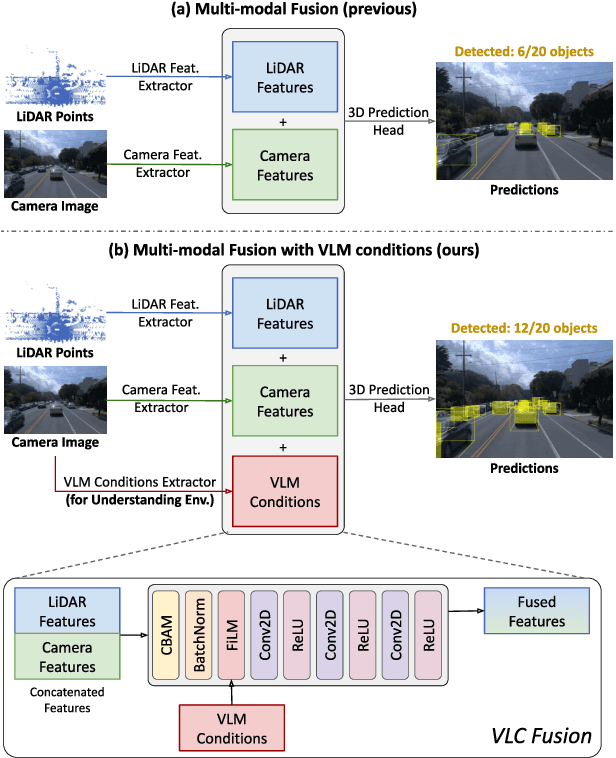

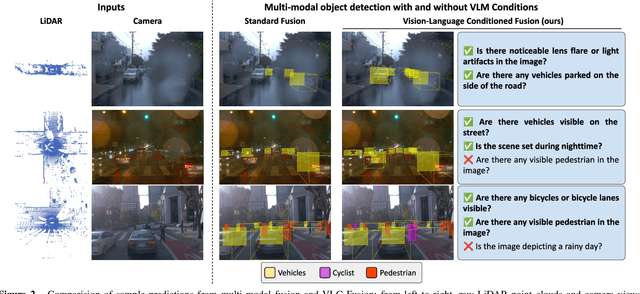
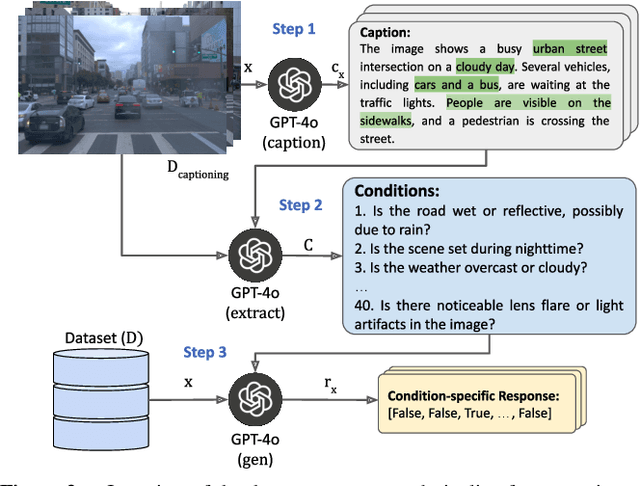
Abstract:Although fusing multiple sensor modalities can enhance object detection performance, existing fusion approaches often overlook subtle variations in environmental conditions and sensor inputs. As a result, they struggle to adaptively weight each modality under such variations. To address this challenge, we introduce Vision-Language Conditioned Fusion (VLC Fusion), a novel fusion framework that leverages a Vision-Language Model (VLM) to condition the fusion process on nuanced environmental cues. By capturing high-level environmental context such as as darkness, rain, and camera blurring, the VLM guides the model to dynamically adjust modality weights based on the current scene. We evaluate VLC Fusion on real-world autonomous driving and military target detection datasets that include image, LIDAR, and mid-wave infrared modalities. Our experiments show that VLC Fusion consistently outperforms conventional fusion baselines, achieving improved detection accuracy in both seen and unseen scenarios.
Calibrating Uncertainty Quantification of Multi-Modal LLMs using Grounding
Apr 30, 2025Abstract:We introduce a novel approach for calibrating uncertainty quantification (UQ) tailored for multi-modal large language models (LLMs). Existing state-of-the-art UQ methods rely on consistency among multiple responses generated by the LLM on an input query under diverse settings. However, these approaches often report higher confidence in scenarios where the LLM is consistently incorrect. This leads to a poorly calibrated confidence with respect to accuracy. To address this, we leverage cross-modal consistency in addition to self-consistency to improve the calibration of the multi-modal models. Specifically, we ground the textual responses to the visual inputs. The confidence from the grounding model is used to calibrate the overall confidence. Given that using a grounding model adds its own uncertainty in the pipeline, we apply temperature scaling - a widely accepted parametric calibration technique - to calibrate the grounding model's confidence in the accuracy of generated responses. We evaluate the proposed approach across multiple multi-modal tasks, such as medical question answering (Slake) and visual question answering (VQAv2), considering multi-modal models such as LLaVA-Med and LLaVA. The experiments demonstrate that the proposed framework achieves significantly improved calibration on both tasks.
Hydra: An Agentic Reasoning Approach for Enhancing Adversarial Robustness and Mitigating Hallucinations in Vision-Language Models
Apr 19, 2025



Abstract:To develop trustworthy Vision-Language Models (VLMs), it is essential to address adversarial robustness and hallucination mitigation, both of which impact factual accuracy in high-stakes applications such as defense and healthcare. Existing methods primarily focus on either adversarial defense or hallucination post-hoc correction, leaving a gap in unified robustness strategies. We introduce \textbf{Hydra}, an adaptive agentic framework that enhances plug-in VLMs through iterative reasoning, structured critiques, and cross-model verification, improving both resilience to adversarial perturbations and intrinsic model errors. Hydra employs an Action-Critique Loop, where it retrieves and critiques visual information, leveraging Chain-of-Thought (CoT) and In-Context Learning (ICL) techniques to refine outputs dynamically. Unlike static post-hoc correction methods, Hydra adapts to both adversarial manipulations and intrinsic model errors, making it robust to malicious perturbations and hallucination-related inaccuracies. We evaluate Hydra on four VLMs, three hallucination benchmarks, two adversarial attack strategies, and two adversarial defense methods, assessing performance on both clean and adversarial inputs. Results show that Hydra surpasses plug-in VLMs and state-of-the-art (SOTA) dehallucination methods, even without explicit adversarial defenses, demonstrating enhanced robustness and factual consistency. By bridging adversarial resistance and hallucination mitigation, Hydra provides a scalable, training-free solution for improving the reliability of VLMs in real-world applications.
PacketCLIP: Multi-Modal Embedding of Network Traffic and Language for Cybersecurity Reasoning
Mar 05, 2025Abstract:Traffic classification is vital for cybersecurity, yet encrypted traffic poses significant challenges. We present PacketCLIP, a multi-modal framework combining packet data with natural language semantics through contrastive pretraining and hierarchical Graph Neural Network (GNN) reasoning. PacketCLIP integrates semantic reasoning with efficient classification, enabling robust detection of anomalies in encrypted network flows. By aligning textual descriptions with packet behaviors, it offers enhanced interpretability, scalability, and practical applicability across diverse security scenarios. PacketCLIP achieves a 95% mean AUC, outperforms baselines by 11.6%, and reduces model size by 92%, making it ideal for real-time anomaly detection. By bridging advanced machine learning techniques and practical cybersecurity needs, PacketCLIP provides a foundation for scalable, efficient, and interpretable solutions to tackle encrypted traffic classification and network intrusion detection challenges in resource-constrained environments.
Multiple Distribution Shift -- Aerial (MDS-A): A Dataset for Test-Time Error Detection and Model Adaptation
Feb 18, 2025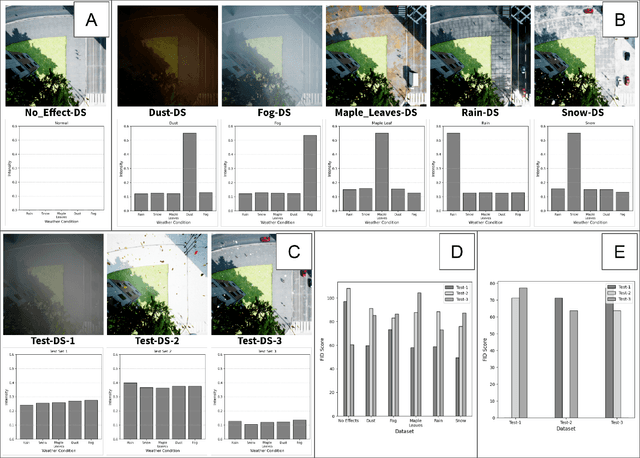


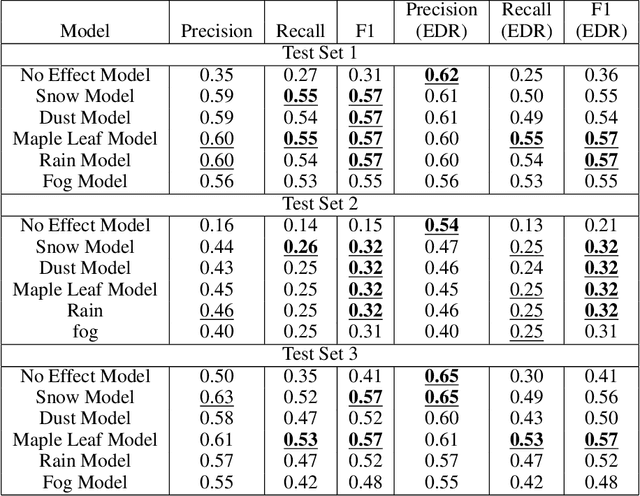
Abstract:Machine learning models assume that training and test samples are drawn from the same distribution. As such, significant differences between training and test distributions often lead to degradations in performance. We introduce Multiple Distribution Shift -- Aerial (MDS-A) -- a collection of inter-related datasets of the same aerial domain that are perturbed in different ways to better characterize the effects of out-of-distribution performance. Specifically, MDS-A is a set of simulated aerial datasets collected under different weather conditions. We include six datasets under different simulated weather conditions along with six baseline object-detection models, as well as several test datasets that are a mix of weather conditions that we show have significant differences from the training data. In this paper, we present characterizations of MDS-A, provide performance results for the baseline machine learning models (on both their specific training datasets and the test data), as well as results of the baselines after employing recent knowledge-engineering error-detection techniques (EDR) thought to improve out-of-distribution performance. The dataset is available at https://lab-v2.github.io/mdsa-dataset-website.
Probabilistic Foundations for Metacognition via Hybrid-AI
Feb 08, 2025Abstract:Metacognition is the concept of reasoning about an agent's own internal processes, and it has recently received renewed attention with respect to artificial intelligence (AI) and, more specifically, machine learning systems. This paper reviews a hybrid-AI approach known as "error detecting and correcting rules" (EDCR) that allows for the learning of rules to correct perceptual (e.g., neural) models. Additionally, we introduce a probabilistic framework that adds rigor to prior empirical studies, and we use this framework to prove results on necessary and sufficient conditions for metacognitive improvement, as well as limits to the approach. A set of future
 Add to Chrome
Add to Chrome Add to Firefox
Add to Firefox Add to Edge
Add to Edge